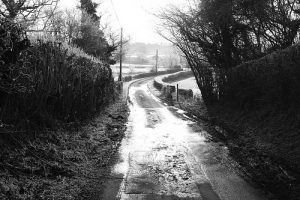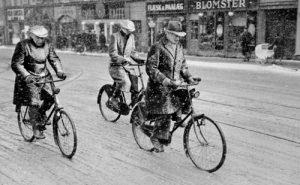It’s cold, wet and dark. Why would you ever commute to work by bike in winter? Well there are a few things that you can do (or have) to make that cycle commute less daunting. Here are some ideas.
Lights
You should have a set of lights charged up; white for the front and red for the rear. If you are in an urban area with lit streets then use flashing modes to help you stand out a bit more.
Be considerate to other road users with your lights though. As a rule of thumb, if your front light is putting out 100 lumens or above, you should check the angle of your mount as you may be dazzling oncoming road users.
Visibility
See and be seen. Apart from having lights, you can also improve your visibility to other road users with reflectives. You will find reflectives on cycling specific clothing and bags. You can also find reflective ankle or arm bands.
Light doesn’t bend around objects or corners* so having lights and reflectives are only part of the solution. Your positioning is more important for seeing and being seen by other road users. All cyclists should consider getting cycle training with a qualified National Standard cycling instructor who can teach you about road positioning and more. We make no apology for the plug; the benefits of cycle training for cyclists of any ability are well documented. For London boroughs where we work, you can book your training session with us for free here!
*Light does bend on the astronomical scale by gravitational lensing as predicted by Einstein’s theory of general relativity but that probably has no place here.
Layer up
Layering up is the obvious preparation in winter. If you have a long ride, you should pay some attention to your layering set-up so that removing a layer mid-ride is an easy affair. Take a waterproof to work even if it’s dry in the morning; the Met Office can’t be 100% accurate day in, day out.
Cover up
When it inevitably gets bitterly cold, you will want to cover up as much as possible. There are cycling hats that can fit under the helmet and extend down to cover your ears too. A neck warmer is another good purchase as you can pull it up to cover most of your face. A pair of clear glasses is a bit of a luxury but works a treat in the hail or on eye watering descents.
Mudguards
We’re big advocates of full length mudguards. Even if it’s not raining, surface water will linger on the roads for a long time and, without mudguards, you’ll be wearing it all up your back. There’s an added benefit to the cyclist behind you too, in the form of avoiding an unwanted baptism by dirty water.
Black Ice
You need to be aware of the possibility of encountering black ice in winter. If you’re “lucky” enough to go over black ice head on, the best countermeasures are: resist the instinct to brake, relax and keep steering straight. If you hit black ice on a corner… you’re in the lap of the gods, sorry.
Obviously, if you are not cycling on the road then you mitigate the risk completely. Assess the roads you ride on; are you in a rural area with sparse traffic or are you in a densely populated urban area? Unsalted rural roads will be peppered with black ice given the right (or wrong) conditions. The timing of your ride is also important; riding urban roads in the morning after peak traffic will slightly lower the chance encountering black ice.
Here we are, well into winter. We’re still commuting by bike so we’ll see you out there!

Leave a Reply